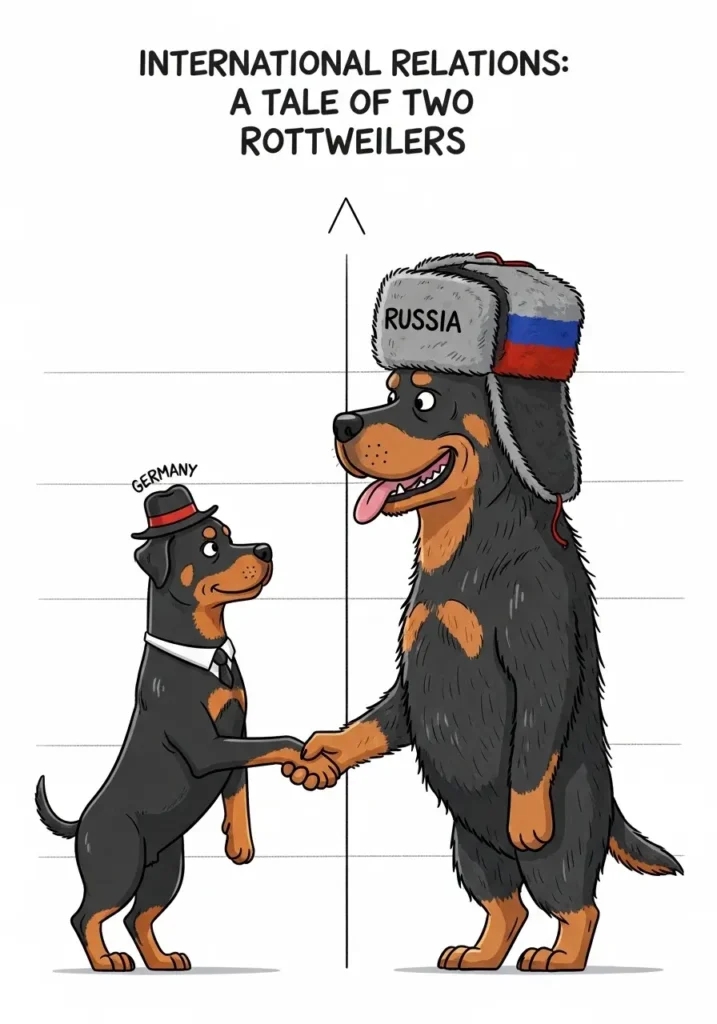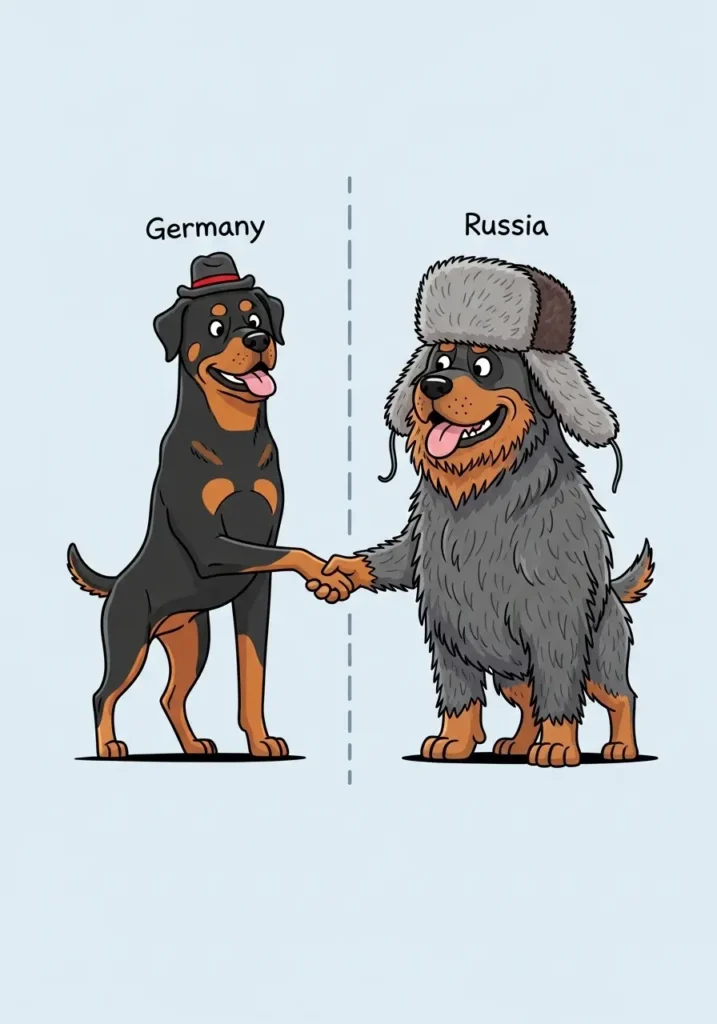People love to flex their “pure Russian Rottweiler” like it’s a badge of honor—bigger, tougher, rarer. You’ll see it plastered across YouTube thumbnails, breeder websites, and Facebook groups filled with proud owners showing off their so-called Russian bloodlines.
But here’s the thing most people don’t know: the Russian Rottweiler isn’t actually an official breed. There’s no kennel club in the world that recognizes it. So why does the term exist? Is it a unique bloodline, a regional variation, or just clever marketing dressed up in a heavy accent?
In this article, we’ll unpack the truth behind the hype. You’ll learn where the “Russian Rottweiler” label came from, how these dogs differ from German and American lines, and what really defines their size, temperament, and appearance.
What People Think a Russian Rottweiler Is

When someone says “Russian Rottweiler,” most people imagine a bigger, stronger, scarier version of the regular Rottweiler kind of like the gym-bro cousin who skipped leg day but still looks intimidating.
They’re supposedly from Russia or Serbia, bred for protection, and known for their massive heads, stocky builds, and thick bones.
Sounds impressive, right? But let’s get one thing straight. There’s no officially recognized Russian Rottweiler breed. Not by the American Kennel Club (AKC), The Kennel Club (UK), or even the Federation Cynologique Internationale (FCI), which is basically the United Nations of dog registries.
So where does the “Russian” label come from? Well, buckle up—it’s less mysterious than you think.
The Origin of the Russian (and Serbian) Rottweiler Label
The German Connection
All Rottweilers Russian, American, Serbian, Martian, whatever trace their roots back to Germany. The name “Rottweiler” literally comes from the town of Rottweil, where these dogs were bred to herd cattle and guard property.
After the breed gained popularity worldwide, local breeders started developing their own bloodlines.
Some focused on bigger builds and thicker frames (common in Eastern Europe), while others bred for a leaner, sportier look (seen in the U.S. and Germany).
The Eastern European Twist
In countries like Russia, Serbia, and Romania, breeders often preferred larger, more muscular dogs with heavier heads and broader chests. They claimed these dogs were better suited for guard work and cold climates.
Over time, people began calling these dogs “Russian Rottweilers” or “Serbian Rottweilers.” But and here’s the kicker they’re still Rottweilers.
The difference lies in breeding style, diet, and regional preferences, not genetics.
Think of it like this: same brand, different models.
Russian vs. German Rottweiler: What’s the Difference, Really?

Let’s settle this once and for all. If both are Rottweilers, how are they different?
Here’s a quick breakdown:
| Feature | German Rottweiler | Russian/Serbian Rottweiler |
|---|---|---|
| Origin | Germany (official) | Eastern Europe (regional line) |
| Build | Balanced, athletic | Heavier, bulkier, more muscular |
| Head Shape | Moderate size | Broader skull, shorter muzzle |
| Tail | Usually natural (not docked in Europe) | Often docked or short |
| Temperament | Calm and obedient | Protective, more territorial |
| Recognition | Official by AKC/FCI | Not recognized as separate breed |
In short, Russian Rottweilers look more intimidating, but both share the same roots, temperament, and loyalty. It’s like comparing a marathon runner and a powerlifter different physiques, same species.
Are Rottweilers Good With Kids? 5 Reasons They Are (and 3 Reasons They’re Not)
Why the Confusion Exists
The internet is a magical place where myths multiply faster than unneutered rabbits. 😅
Some breeders market “Russian” or “Serbian” Rottweilers as exclusive bloodlines to justify higher prices. And, let’s be honest, “Russian Rottweiler” just sounds cooler than “regular ol’ Rottweiler from Stuttgart.”
FYI: There’s no DNA test that will come back and say, “Congratulations, your dog is 80% Russian Rottweiler.” The term is 100% marketing, 0% science.
But here’s the thing it doesn’t mean these dogs are bad or fake. It just means the label doesn’t define the breed. What matters is how the dog’s raised, trained, and cared for.
Rottweiler with White Chest and Paws: Is It Normal or a Sign of a Mix?
How to Tell If You’re Buying a Legit Rottweiler

If you’re thinking of getting one, good call. They’re smart, loyal, and make excellent family dogs (as long as you’re ready for some serious drool and shedding). But beware of breeders who overhype the “Russian” angle.
Here’s how to spot the real deal:
- Ask for pedigree papers. Authentic breeders will show documents from recognized organizations like the FCI, ADRK, or AKC.
- Meet the parents. If they’re claiming “Russian bloodlines,” ask to see both parents. Look for temperament, structure, and health.
- Look at the dog, not the label. Focus on traits broad chest, confident posture, steady eyes.
- Avoid buzzwords. Words like “super rare Russian line” or “giant head version” are red flags.
- Vet the breeder. Check reviews, ask for references, and confirm they health-test their dogs.
If a breeder’s story sounds like a sales pitch instead of a fact sheet, walk away. There are plenty of honest breeders out there who’ll tell you the truth.
Rottweiler Growth Stages Explained (With Photos and Real Examples)
Temperament: Same Breed, Same Soul
Now, let’s talk personality because let’s face it, looks aren’t everything.
Whether your Rottweiler comes from Moscow or Munich, their core traits stay the same. They’re loyal, intelligent, and protective. They form deep bonds with their families and can switch from “gentle cuddle bear” to “bodyguard mode” in a heartbeat.
Some owners claim Russian or Serbian Rottweilers are more territorial or aggressive, but that’s usually about training, not geography. A well-socialized Rottie is calm, obedient, and confident. An undertrained one, regardless of origin, can be a handful.
So, if your Rottweiler acts like he’s guarding the Kremlin, don’t blame Russia blame a lack of boundaries. 😏
Physical Traits That Make Russian Rottweilers Stand Out
While there’s no official breed standard for a “Russian Rottweiler,” most of these dogs share some noticeable traits:
- Bigger bone structure – They often have thicker necks and more muscle mass.
- Wider skulls – The head appears bulkier, giving them that “tough guy” look.
- Dense coat – Perfect for colder regions.
- Shorter muzzle – Sometimes gives them a stronger jaw appearance.
These traits can make them seem more intimidating, which is great if you’re looking for a guard dog but remember, appearance doesn’t equal personality.
Training and Care: No Russian Secrets Here
There’s no mystical Siberian training method that makes these dogs special. Every Rottweiler, regardless of where it’s from, needs the same basics:
1. Early Socialization
Expose your pup to people, pets, and new environments early. The more confident they become, the less likely they’ll grow into anxious or reactive adults.
2. Positive Reinforcement
Use treats, praise, and consistency. Avoid harsh punishment it only builds fear, not respect.
3. Regular Exercise
These dogs need daily workouts walks, play sessions, or even mental games. A bored Rottie can turn your living room into a chew toy showroom.
4. Healthy Diet
High-protein, balanced meals are essential. If you feed junk, you’ll get a sluggish dog. Simple as that.
5. Routine Vet Care
Stay on top of vaccines, checkups, and dental cleaning. Big dogs often hide pain until it’s serious.
Russian or not, a Rottweiler thrives on structure, love, and activity. Skip those, and you’ll have chaos wrapped in fur.
The Myth of “Pure” Bloodlines
Breeders love tossing around words like “pure Russian” or “authentic Serbian bloodline.” But let’s be real—unless they’ve got time machines, no one’s breeding ancient Russian wolves here.
All modern Rottweilers come from the same German roots, period. The differences you see—size, muscle tone, head shape come from breeding preferences, not separate ancestry.
And that’s fine! Diversity in lines is normal. What’s not fine is when someone uses that diversity to overcharge or mislead.
So next time you see a “Russian Rottweiler for sale” ad, remember: it’s a marketing label, not a scientific category.
Common Myths (Busted!)

Let’s bust a few of the internet’s favorite Rottie myths:
- “Russian Rottweilers are a separate breed.” Nope. Just bigger, regional lines.
- “They’re more aggressive.” Only if you raise them that way.
- “They’re from Russia.” The name’s just branding. The breed’s still 100% German.
- “Bigger means better.” Not really. Bigger dogs can face more health problems like hip dysplasia.
Don’t fall for flashy adjectives. Focus on the dog’s health, temperament, and how well they fit your lifestyle.
Should You Get a Russian Rottweiler?
If you love strong, loyal, slightly dramatic dogs (because let’s face it, Rotties have personalities), then yes you’ll adore them. But don’t get hung up on labels.
Choose a dog based on:
- Temperament – Calm but confident.
- Health – Ask for test results.
- Breeder honesty – Transparency matters.
- Your lifestyle – They need time, training, and patience.
Owning a Rottweiler isn’t like buying furniture. You’re signing up for a decade of drool, loyalty, and the occasional “did you just eat the couch?” moment.
Final Thoughts: So, Are Russian Rottweilers Real?
Here’s the truth: Russian Rottweilers aren’t a separate breed. They’re Rottweilers bred in Eastern Europe, often bulkier and tougher-looking, but genetically the same as their German cousins.
The term “Russian” sounds exotic and cool, sure, but don’t let it fool you into paying extra or expecting a superhero dog. A Rottweiler’s greatness comes from training, care, and love not its passport.
So, next time someone tells you they’ve got a “pure Russian Rottweiler,” just smile and say, “Ah, so… a Rottweiler then?” 😉
At the end of the day, whatever you call them Russian, Serbian, or just plain Rottie one thing’s for sure: these dogs will guard your home, love your family, and probably steal your spot on the couch. And honestly? That’s what makes them really special. ❤️
